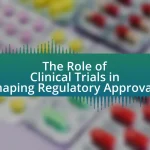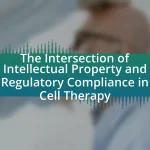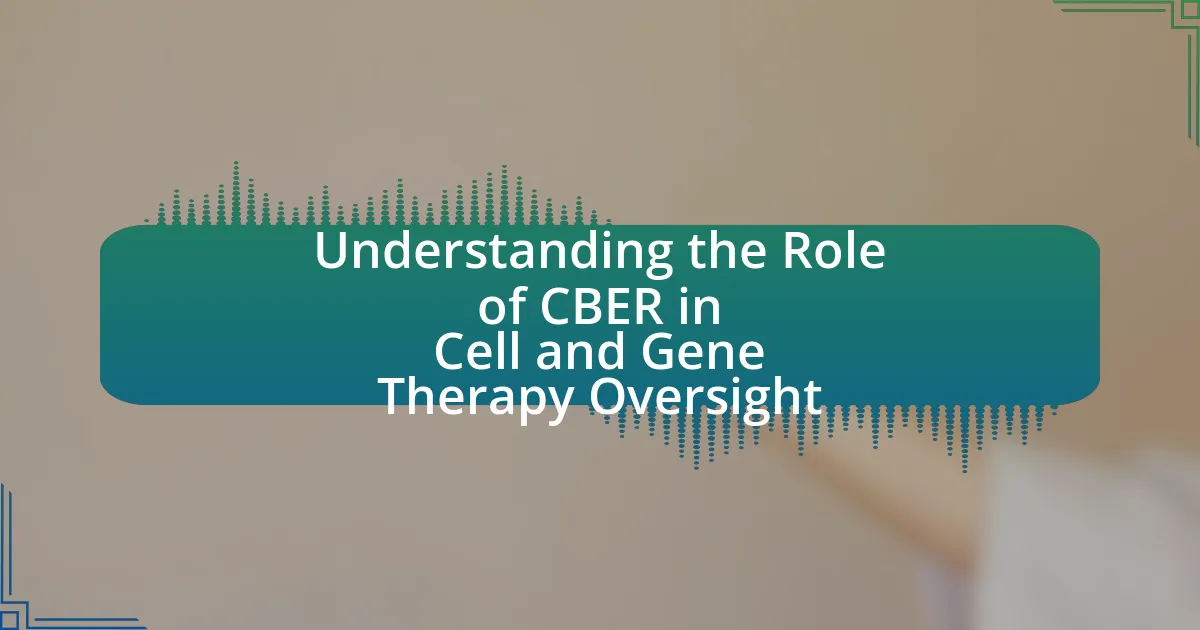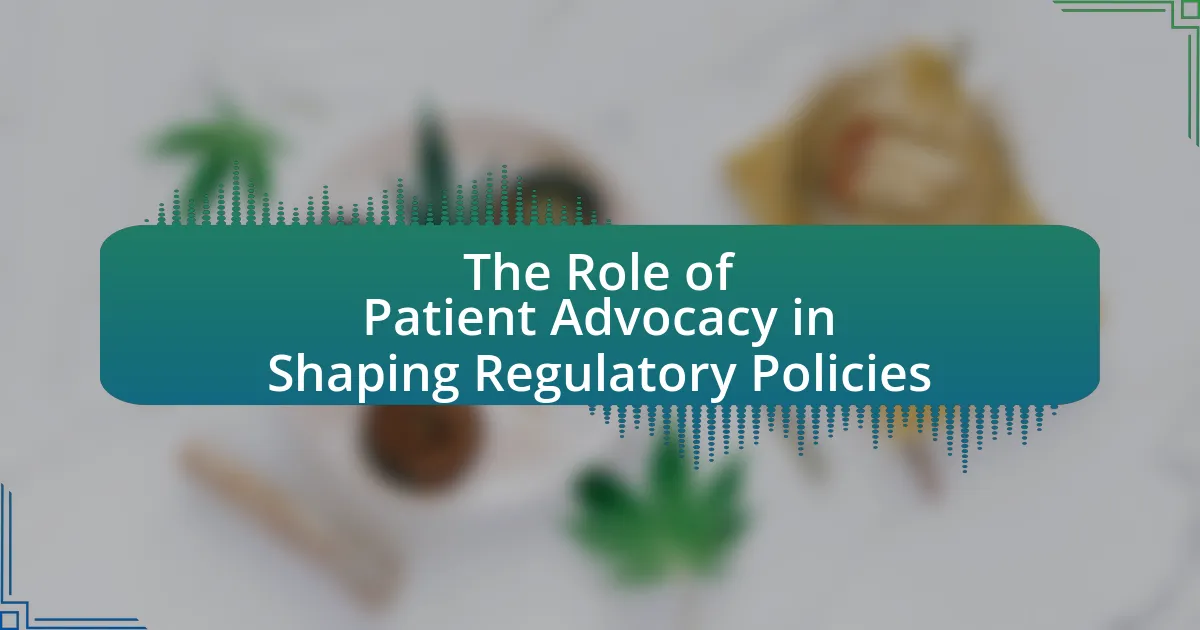The article focuses on the critical role of the FDA in accelerating the approval process for cell and gene therapies. It outlines the FDA’s implementation of expedited review pathways, such as the Breakthrough Therapy designation and the Regenerative Medicine Advanced Therapy designation, which facilitate faster access to innovative treatments while ensuring safety and efficacy. The article also defines cell and gene therapies, discusses their key characteristics, and highlights the potential risks associated with these therapies. Additionally, it examines the challenges the FDA faces in balancing safety with the urgency of patient needs, the significance of public input, and the impact of FDA approval on market access and future advancements in the field.

What is the Role of FDA in Accelerating Cell and Gene Therapy Approvals?
The FDA plays a crucial role in accelerating cell and gene therapy approvals by implementing expedited review pathways such as the Breakthrough Therapy designation and the Regenerative Medicine Advanced Therapy designation. These pathways allow for faster evaluation of therapies that demonstrate substantial improvement over existing treatments for serious conditions. For instance, the FDA has approved several gene therapies, including Zolgensma for spinal muscular atrophy, under these expedited processes, significantly reducing the time from clinical trials to market. This approach not only facilitates timely access to innovative treatments but also ensures that safety and efficacy standards are maintained, thereby supporting public health.
How does the FDA define cell and gene therapies?
The FDA defines cell and gene therapies as products that involve the use of living cells or genetic material to treat or prevent diseases. Specifically, cell therapies involve the administration of cells to a patient to repair or replace damaged tissues or cells, while gene therapies involve the introduction, removal, or alteration of genetic material within a patient’s cells to treat or prevent disease. This definition is supported by the FDA’s regulatory framework, which categorizes these therapies under biologics and emphasizes their innovative nature in addressing unmet medical needs.
What are the key characteristics of cell therapies?
Cell therapies are characterized by their ability to use living cells to treat diseases, primarily by repairing, replacing, or regenerating damaged tissues or organs. These therapies often involve the manipulation of cells, such as stem cells or immune cells, to enhance their therapeutic potential. For instance, CAR-T cell therapy modifies T cells to better target and destroy cancer cells, demonstrating the innovative application of cell manipulation in treatment. Additionally, cell therapies can be autologous, using a patient’s own cells, or allogeneic, using cells from a donor, which influences their compatibility and effectiveness. The FDA has recognized the importance of these characteristics in its regulatory framework, facilitating the approval process for therapies that show promise in clinical trials.
What distinguishes gene therapies from other treatments?
Gene therapies are distinguished from other treatments by their ability to directly modify the genetic material of a patient’s cells to treat or prevent disease. Unlike traditional treatments that often focus on alleviating symptoms or managing conditions, gene therapies aim to address the underlying genetic causes of diseases, such as inherited disorders or certain types of cancer. This approach can lead to long-lasting effects, as evidenced by the success of therapies like Luxturna, which treats a specific genetic form of blindness by delivering a functional copy of the RPE65 gene directly to retinal cells.
Why is the FDA’s role critical in the approval process?
The FDA’s role is critical in the approval process because it ensures the safety and efficacy of medical products, including cell and gene therapies. By conducting rigorous evaluations of clinical trial data, the FDA protects public health and prevents the distribution of ineffective or harmful treatments. For instance, the FDA has established specific guidelines and expedited pathways, such as the Breakthrough Therapy designation, to facilitate the timely review of innovative therapies while maintaining high safety standards. This regulatory oversight is essential for fostering trust in the healthcare system and ensuring that new therapies meet established scientific and ethical standards before reaching patients.
What are the potential risks of cell and gene therapies?
The potential risks of cell and gene therapies include adverse immune reactions, insertional mutagenesis, and off-target effects. Adverse immune reactions can occur when the body’s immune system attacks the introduced cells or gene products, potentially leading to severe complications. Insertional mutagenesis refers to the unintended integration of therapeutic genes into the genome, which can disrupt normal gene function and lead to cancer. Off-target effects involve unintended modifications to the genome, which may result in harmful consequences. These risks highlight the need for thorough preclinical and clinical evaluations to ensure patient safety and efficacy in cell and gene therapies.
How does the FDA ensure patient safety during approvals?
The FDA ensures patient safety during approvals by implementing a rigorous evaluation process for new therapies. This process includes preclinical studies, clinical trials, and a thorough review of data regarding safety and efficacy. The FDA requires that clinical trials follow Good Clinical Practice guidelines, which mandate informed consent and monitoring for adverse effects. Additionally, the FDA utilizes advisory committees composed of independent experts to provide recommendations based on the data submitted. This multi-tiered approach, which includes post-marketing surveillance to monitor long-term safety, reinforces the FDA’s commitment to protecting patient health throughout the approval process.
What processes does the FDA use to accelerate approvals?
The FDA uses several processes to accelerate approvals, including the Fast Track designation, Breakthrough Therapy designation, Accelerated Approval pathway, and Priority Review designation. Fast Track designation facilitates the development and expedites the review of drugs that treat serious conditions and fill an unmet medical need, allowing for more frequent communication with the FDA. Breakthrough Therapy designation is granted to drugs that show substantial improvement over existing therapies, providing similar benefits in terms of expedited development and review. The Accelerated Approval pathway allows for earlier approval of drugs based on surrogate endpoints that are reasonably likely to predict clinical benefit, while Priority Review designation shortens the review time from ten months to six months for drugs that offer significant improvements in safety or effectiveness. These processes are designed to bring important therapies to patients more quickly while ensuring safety and efficacy.
What is the significance of the Breakthrough Therapy designation?
The Breakthrough Therapy designation is significant because it expedites the development and review process for drugs that treat serious conditions and fill an unmet medical need. This designation allows for more intensive guidance from the FDA during the development process, which can lead to faster patient access to potentially life-saving therapies. According to the FDA, this designation is intended to facilitate the availability of new treatments by providing sponsors with opportunities for early and frequent communication with the agency, thereby enhancing the efficiency of the clinical trial process.
How does the FDA utilize expedited review pathways?
The FDA utilizes expedited review pathways to accelerate the approval process for therapies that address unmet medical needs, particularly in serious or life-threatening conditions. These pathways include Fast Track designation, Breakthrough Therapy designation, Accelerated Approval, and Priority Review, each designed to facilitate more efficient development and review of promising therapies. For instance, the Fast Track designation allows for more frequent communication between the FDA and developers, while the Breakthrough Therapy designation provides intensive guidance on efficient drug development. The Accelerated Approval pathway permits approval based on surrogate endpoints that are reasonably likely to predict clinical benefit, enabling earlier access to therapies. These mechanisms have been instrumental in expediting the approval of innovative cell and gene therapies, as evidenced by the rapid approvals of treatments for conditions like spinal muscular atrophy and certain types of cancer.

What challenges does the FDA face in accelerating approvals?
The FDA faces several challenges in accelerating approvals, primarily related to balancing safety and efficacy with the urgency of patient needs. One significant challenge is the complexity of evaluating innovative therapies, such as cell and gene therapies, which often involve novel mechanisms of action and limited historical data for comparison. Additionally, the FDA must navigate regulatory frameworks that may not be fully equipped to handle the rapid advancements in biotechnology, leading to potential delays in the review process. Furthermore, the agency encounters resource constraints, including staffing and funding limitations, which can hinder its ability to expedite reviews effectively. These challenges are compounded by the need for robust post-market surveillance to ensure long-term safety, which can further complicate the approval timeline.
What are the common regulatory hurdles for cell and gene therapies?
Common regulatory hurdles for cell and gene therapies include complex manufacturing processes, stringent safety and efficacy requirements, and the need for extensive clinical trial data. These therapies often require specialized facilities and quality control measures to ensure consistent product quality, which can complicate the approval process. Additionally, regulatory agencies like the FDA demand comprehensive evidence demonstrating that the therapies are safe and effective, leading to lengthy review timelines. For instance, the FDA’s Breakthrough Therapy designation aims to expedite the development of therapies that treat serious conditions, yet the initial regulatory requirements remain rigorous, often resulting in delays for developers.
How do manufacturing complexities impact the approval process?
Manufacturing complexities significantly delay the approval process for cell and gene therapies. These complexities arise from the intricate nature of biological products, which often require precise conditions for production, quality control, and validation. For instance, variations in cell sourcing, culture conditions, and vector design can lead to inconsistencies that necessitate extensive testing and documentation. According to a report by the FDA, the majority of delays in the approval process are attributed to manufacturing issues, highlighting that 70% of the complete response letters issued by the FDA cite manufacturing deficiencies. This underscores the critical need for robust manufacturing processes to ensure compliance with regulatory standards, ultimately impacting the timeline for bringing therapies to market.
What role does clinical trial design play in regulatory challenges?
Clinical trial design is crucial in navigating regulatory challenges, as it directly influences the assessment of safety and efficacy by regulatory bodies like the FDA. A well-structured trial design ensures that the data generated meets regulatory standards, facilitating timely approvals. For instance, adaptive trial designs allow for modifications based on interim results, which can address safety concerns and optimize patient outcomes, thereby aligning with regulatory expectations. Furthermore, clear endpoints and robust statistical methodologies in trial designs provide the necessary evidence for regulatory review, as seen in the accelerated approval of therapies like Zolgensma for spinal muscular atrophy, where the trial design was pivotal in demonstrating significant clinical benefit.
How does the FDA collaborate with stakeholders to overcome challenges?
The FDA collaborates with stakeholders through various initiatives, including public meetings, advisory committees, and partnerships with industry and academic organizations. These collaborative efforts aim to address challenges in the regulatory landscape, particularly in the context of accelerating cell and gene therapy approvals. For instance, the FDA’s Patient Engagement Advisory Committee allows for direct input from patients and advocates, ensuring that their perspectives inform regulatory decisions. Additionally, the FDA has established the Regenerative Medicine Advanced Therapy (RMAT) designation, which facilitates expedited development and review processes for therapies that address unmet medical needs. This designation exemplifies how the FDA works with stakeholders to streamline approvals while maintaining safety and efficacy standards.
What partnerships exist between the FDA and industry leaders?
The FDA has established partnerships with industry leaders through initiatives like the FDA’s Breakthrough Therapy Designation and the Accelerated Approval Program. These collaborations aim to expedite the development and approval of innovative therapies, particularly in the fields of cell and gene therapy. For instance, the FDA collaborates with organizations such as the Biotechnology Innovation Organization (BIO) and the Cell and Gene Therapy Catapult to enhance regulatory pathways and share scientific knowledge. These partnerships facilitate a more efficient review process, allowing for faster patient access to groundbreaking treatments.
How does public input influence FDA decision-making?
Public input significantly influences FDA decision-making by providing diverse perspectives that inform regulatory processes. The FDA actively solicits feedback from stakeholders, including patients, healthcare professionals, and industry representatives, during public meetings and comment periods. This input helps the FDA understand the real-world implications of therapies, particularly in the context of cell and gene therapies, where patient experiences can highlight unmet medical needs. For instance, the FDA’s Patient-Focused Drug Development initiative incorporates patient insights to shape the evaluation of treatment benefits and risks, ensuring that decisions align with patient priorities. This approach has been instrumental in expediting the approval of innovative therapies, as seen in the accelerated pathways established for breakthrough therapies, which rely on robust public engagement to validate the therapeutic value.
What impact does the FDA’s role have on the future of cell and gene therapies?
The FDA’s role significantly influences the future of cell and gene therapies by establishing regulatory frameworks that ensure safety and efficacy. This regulatory oversight is crucial as it fosters innovation while protecting public health, thereby encouraging investment in research and development. For instance, the FDA’s expedited approval pathways, such as the Breakthrough Therapy designation, have already facilitated the rapid introduction of therapies like CAR-T cell treatments, which have shown remarkable success in treating certain cancers. By continuing to adapt its regulatory processes to the evolving landscape of biotechnology, the FDA can enhance the accessibility of transformative therapies, ultimately shaping the trajectory of advancements in this field.
How does FDA approval influence market access for therapies?
FDA approval significantly influences market access for therapies by providing a regulatory endorsement that assures safety and efficacy. This endorsement enables manufacturers to market their therapies to healthcare providers and patients, facilitating reimbursement negotiations with insurers. For instance, therapies that receive FDA approval often gain faster access to the market compared to those that do not, as seen with the accelerated approval pathways established for breakthrough therapies. Additionally, FDA approval can enhance investor confidence, leading to increased funding and support for further development and commercialization efforts.
What trends are emerging in cell and gene therapy approvals?
Emerging trends in cell and gene therapy approvals include an increase in the number of therapies receiving expedited pathways, such as Breakthrough Therapy Designation and Accelerated Approval from the FDA. In 2022, the FDA approved a record number of gene therapies, reflecting a growing acceptance of these treatments for various genetic disorders and cancers. Additionally, there is a notable shift towards combination therapies that integrate gene editing technologies, like CRISPR, with traditional treatment modalities. This trend is supported by the FDA’s commitment to streamline the approval process, as seen in the approval of Zynteglo for beta-thalassemia in 2022, which marked a significant milestone in the regulatory landscape for gene therapies.
How does FDA guidance shape research and development in the field?
FDA guidance shapes research and development in the field of cell and gene therapy by establishing clear regulatory frameworks that inform the design, conduct, and analysis of clinical trials. These guidelines provide researchers with essential information on safety, efficacy, and quality standards, which are critical for the successful development of therapies. For instance, the FDA’s guidance on the development of gene therapies outlines specific considerations for preclinical studies and clinical trial design, ensuring that developers understand the necessary steps to meet regulatory requirements. This structured approach not only streamlines the approval process but also enhances the likelihood of successful outcomes by aligning research efforts with regulatory expectations.
What best practices can developers follow to navigate the FDA approval process?
Developers can navigate the FDA approval process effectively by engaging in early and continuous communication with the FDA, which helps clarify regulatory expectations and requirements. This proactive approach allows developers to address potential issues before they escalate, ensuring that their submissions meet the necessary standards. Additionally, developers should conduct thorough preclinical studies and gather robust clinical data to support their applications, as the FDA relies heavily on this evidence to assess safety and efficacy. Utilizing the FDA’s guidance documents and participating in the FDA’s expedited programs, such as Breakthrough Therapy Designation, can further streamline the approval process. These practices are supported by the FDA’s commitment to facilitating the development of innovative therapies, as outlined in their regulatory framework.
How can developers effectively prepare for FDA submissions?
Developers can effectively prepare for FDA submissions by thoroughly understanding the regulatory requirements and guidelines specific to their product type. This involves conducting comprehensive preclinical studies, ensuring robust clinical trial designs, and maintaining clear documentation throughout the development process. For instance, developers should familiarize themselves with the FDA’s guidance documents, such as the “Guidance for Industry: Gene Therapy for Rare Diseases,” which outlines critical considerations for submissions. Additionally, engaging with the FDA through pre-submission meetings can provide valuable insights and clarify expectations, thereby increasing the likelihood of a successful submission.
What resources are available to assist in understanding FDA regulations?
The resources available to assist in understanding FDA regulations include the FDA’s official website, which provides comprehensive guidance documents, regulatory information, and educational materials. The FDA’s Center for Biologics Evaluation and Research (CBER) offers specific resources related to cell and gene therapies, including webinars and workshops aimed at stakeholders. Additionally, the FDA provides access to the Federal Register, where proposed rules and regulations are published, allowing for public comment and engagement. These resources are essential for navigating the complex regulatory landscape surrounding FDA approvals.




